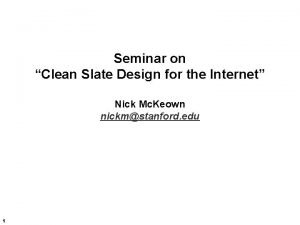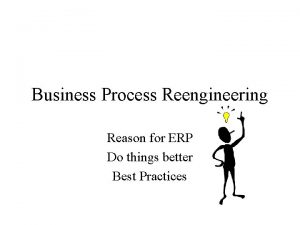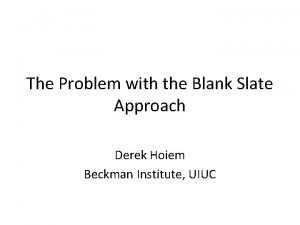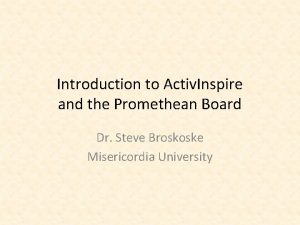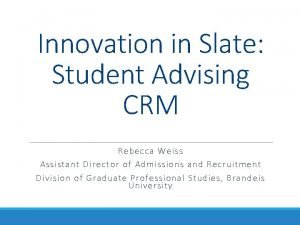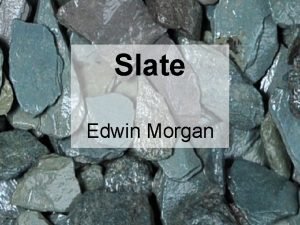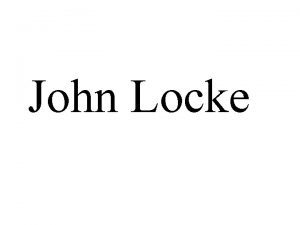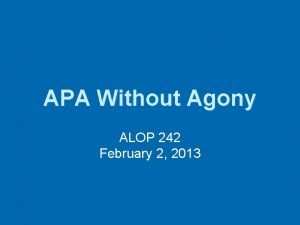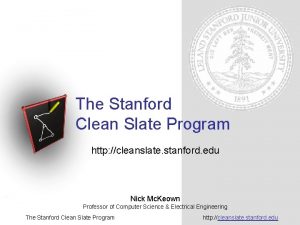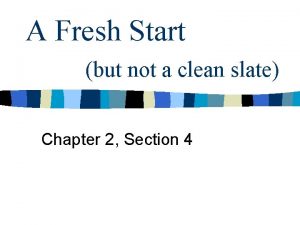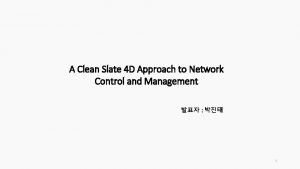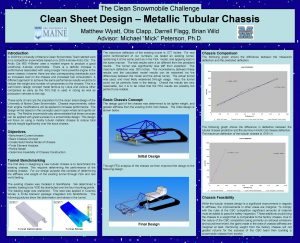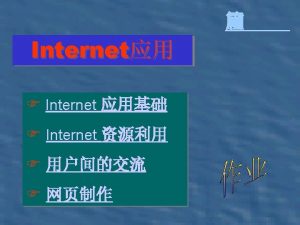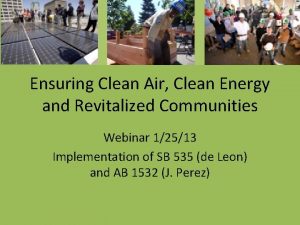Seminar on Clean Slate Design for the Internet
























- Slides: 24

Seminar on “Clean Slate Design for the Internet” Nick Mc. Keown nickm@stanford. edu 1

High level 2 v “Given what we know today, if we were to start over with a Clean Slate, how would we design a global communications network? ” v “Ideally, how will the network look in 15 -20 years, and how will we get there from here? ”

Prelims 3 v What’s wrong with the Internet…? v Why is the research and business community not already solving it? v What are other groups doing? v What we plan to do at Stanford v An example of “Clean Slate” design

Original Architecture 4 v A dumb connectionless packet-forwarding packetswitched infrastructure, with high-level functionality at the edge v Single, simple lowest-common denominator data delivery service (IP), with reliable stream service built on top v Fixed-size numerical addresses with {network, host} hierarchy; one per physical network interface v Later § Separation of IP and TCP (including congestion control using packet loss as congestion signal) § Subnetting, autonomous systems (EGPs and IGPs), DNS, CIDR

What is needed v Wouldn’t we like a network that we can trust to be always there, always on, easy to use, universally accessible, secure, and economically viable. v David Cheriton’s example: If the FAA carried all of its traffic over the public Internet, you'd be nuts to fly. v Some obvious desirable characteristics v 5 § Robustness and Availability § Security § Naming and Addressing: accountability vs anonymity § Predictability § Mobility § Economic Viability What else?

Prelims 6 v What’s wrong with the Internet…? v Why is the research and business community not already solving it? v What are other groups doing? v What we plan to do at Stanford v An example of “Clean Slate” design

Prelims 7 v What’s wrong with the Internet…? v Why is the research and business community not already solving it? v What are other groups doing? v What we plan to do at Stanford v An example of “Clean Slate” design

What are others doing? v 8 Background § Incrementalism and “victim of success” of Internet § New era of more radical and fundamental thinking about the future of networks and communications v New-arch (MIT) v 100 x 100 (CMU) v Geni (NSF/Gov)

New-arch (2000) v v 9 Requirements for new network § Mobility: Highly dynamic and efficient § Policy-driven auto-configuration § Highly time-variable resources § Allocation of capacity http: //www. isi. edu/newarch/

100 x 100 (CMU/Stanford/Rice) v NSF Large ITR (2003 -2008) v Questions: v 10 § Can structure be used to make networks more robust, predictable and manageable? § What economic principles drive the operation of access and backbone networks? § What security primitives must be built into the network? § Can/should network and protocol architectures be designed to take advantage of long-term technology trends? http: //100 x 100 network. org/

NSF Geni Initiative (2005) 11 v CISE major effort, seeking congressional funding of approx $300 M starting 2008 v Two parts: Research program; Global experimental facility to explore new architectures v Areas of interest: § Creating new core functionality, including naming, addressing, identity, management. § Developing enhanced capabilities: building security intot he architecture; design for high availability; privacy/accountability; design for regional differences and local values § Deploying and validating new architectures § Building higher-level service abstractions § Building new services and applications § Developing new network architecture theories

Prelims 12 v What’s wrong with the Internet…? v Why is the research and business community not already solving it? v What are other groups doing? v What we plan to do at Stanford v An example of “Clean Slate” design

Prelims 13 v What’s wrong with the Internet…? v Why is the research and business community not already solving it? v What are other groups doing? v What we plan to do at Stanford v An example of “Clean Slate” design

What we plan to do at Stanford v Weekly Seminar in Fall and Winter § v 14 Fall: Talk by professor followed by discussion Goals § To get thinking about the problem § To learn from each other § To identify some collaborative research projects

Prelims v What’s wrong with the Internet…? v Why is the research and business community not already solving it? v What are other groups doing? v What we plan to do at Stanford v An example of “Clean Slate” design How to design backbone networks from a clean slate? 15

Backbone Networks: Emerging Structure v 10 -50 routing centers interconnected by long-haul optical links v Increasingly rich topology for robustness and loadbalancing v Typical utilization < 25%, because v 16 § Uncertainty of traffic matrix network is designed for § Headroom for future growth § Headroom to carry traffic when links and routers fail § Minimize congestion and delay variation Efficiency sacrificed for robustness and low queueing delay

How flexible are networks today? What fraction of allowable traffic matrices can they support? Abilene 25% Over Prov: 0. 025% 50% Over Prov: 0. 66% AT&T 25% Over Prov: 0. 0006% 50% Over Prov: 0. 15% 17 Verio 25% Over Prov: 0. 0004% 50% Over Prov: 1. 15% Sprint 25% Over Prov: 0. 0003% 50% Over Prov: 0. 06% Verio, AT&T and Sprint topologies are from Rocket. Fuel

Desired Characteristics v Robust Recovers quickly; continues to operate under failure v Flexible Will support broad class of applications, new customers, and traffic patterns v Predictable Can predict how it will perform, with and without failures v Efficient Does not sacrifice cost for robustness 18

Backbone Design v 19 Assume underlying reliable mesh of physical circuits 1. Dynamic circuit switching over underlying mesh, or 2. Load-balanced logical network. Describing today

Approach v Assume we know/estimate traffic entering and leaving each Regional Network § v Use Valiant Load Balancing (VLB) over whole network § 20 Requires only local knowledge of users and market estimates Enables support of all traffic matrices

Valiant Load-Balancing 2 r 1 r 2 /r. N r 1 1 r. N r 2 2 3 N … 4 r 4 Capacity provisioned over existing robust mesh of physical circuits 21 r 3

A Predictable Backbone Network v v v 22 Performance: 100% throughput for any valid traffic matrix. § Only need to know aggregate node traffic. § Under low load, no need to spread traffic. Robustness § Upon failure, spread over working paths § Small cost to recover from k failures: Provision approx 2 rirj/r(N-k) § Simple routing algorithm Efficient § VLB is lowest cost method to support all traffic matrices § Similar cost, while supporting significantly more traffic matrices.

How expensive would VLB be? Cost normalized to VLB routing. Cost of switching = cost of transmission for 370 miles Abilene 25% Over Prov: 0. 026% Cost: 0. 87 50% Over Prov: 0. 66% Cost: 1. 04 AT&T 25% Over Prov: 0. 0004% Cost: 0. 94 50% Over Prov: 0. 14% Cost: 1. 12 23 Verio 25% Over Prov: 0. 0003% Cost: 0. 99 50% Over Prov: 1. 08% Cost: 1. 19 Sprint 25% Over Prov: 0. 0002% Cost: 0. 86 50% Over Prov: 0. 04% Cost: 1. 04

Open questions v 24 Worst case propagation delay doubled § Low variance in delay § There are “express paths” v (How) are multiple VLB networks connected, and how does performance change? v Economics and policy: how do operators compete?
 Clean slate design
Clean slate design Business process reengineering in erp
Business process reengineering in erp Clean up everybody let's clean up
Clean up everybody let's clean up Slateui
Slateui Blank slate approach
Blank slate approach Tasman chemicals
Tasman chemicals Activ inspire
Activ inspire Slate student crm
Slate student crm Formation of sedimentary rocks leaving cert
Formation of sedimentary rocks leaving cert Slate edwin morgan
Slate edwin morgan Barron de montesquieu
Barron de montesquieu Catamount slate products v sheldon
Catamount slate products v sheldon Slate citation machine
Slate citation machine Slate reading
Slate reading Ted moallem
Ted moallem Whats the parent rock of slate
Whats the parent rock of slate How are metamorphic rocks classified
How are metamorphic rocks classified Slate ui framework
Slate ui framework Jerry cain slate
Jerry cain slate Topeka bodega
Topeka bodega Internet or internet
Internet or internet Pertanyaan tentang design
Pertanyaan tentang design Iso 22301 utbildning
Iso 22301 utbildning Novell typiska drag
Novell typiska drag Nationell inriktning för artificiell intelligens
Nationell inriktning för artificiell intelligens
